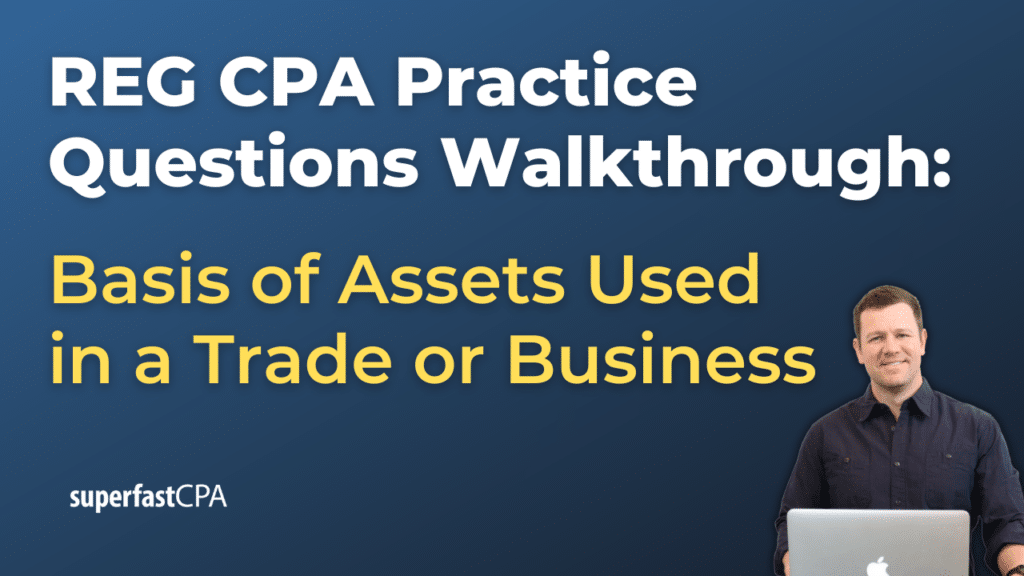In this video, we walk through 5 REG practice questions demonstrating how to calculate the tax basis of assets purchased for use in a business. These questions are from REG content area 3 on the AICPA CPA exam blueprints: Taxation of Property Transactions.
The best way to use this video is to pause each time we get to a new question in the video, and then make your own attempt at the question before watching us go through it.
Also be sure to watch one of our free webinars on the 6 “key ingredients” to an extremely effective & efficient CPA study process here…
How to Calculate the Tax Basis of Assets Purchased for Use in a Business
Calculating the initial tax basis of an asset purchased for use in a trade or business involves determining the total cost of acquiring the asset and preparing it for its intended use. Here’s a simplified overview focusing solely on calculating the initial basis:
1. Purchase Price
The starting point for calculating the initial tax basis is the purchase price of the asset. This includes the amount paid to acquire the asset before any adjustments.
2. Add Additional Costs
To the purchase price, add any additional costs directly associated with acquiring and preparing the asset for use in your business.
These costs can include:
- Sales Taxes: Any sales tax paid at the time of purchase.
- Delivery Charges: Costs incurred to deliver the asset to its intended location.
- Installation and Setup Fees: Expenses related to installing or setting up the asset, making it ready for use.
- Legal and Professional Fees: If legal or professional services (like an attorney or an accountant) were needed specifically for the acquisition, these fees are added to the basis.
- Site Preparation Costs: Expenses to prepare the location where the asset will be used, such as clearing land or building modifications necessary for installation.
3. Capitalize Direct Costs
All costs that are directly attributable to acquiring the asset and preparing it for use should be capitalized as part of the asset’s basis. This means these costs are not expensed immediately but are included in the basis of the asset for depreciation purposes.
Example: Construction of a Business Building
- ABC Corporation decides to construct a building for its new office space.
- The total cost of construction is estimated to be $1,000,000.
- Land cost for the building site is $200,000.
- Additional expenses are incurred during the construction process.
Costs Included in the Tax Basis of the Building:
- Construction Costs: All costs directly related to the construction of the building, such as labor and materials, totaling $800,000.
- Architectural and Design Fees: Fees paid to architects for the design of the building, amounting to $50,000.
- Building Permits and Fees: Costs paid to local government for permits and fees required for construction, totaling $20,000.
- Utility Connection Fees: Costs to connect the building to necessary utilities (electricity, water, sewer), which are $10,000.
- Interest Expenses: Interest on loans specifically taken out to finance the construction of the building until it is ready for use, amounting to $30,000.
- Land Improvements Directly Related to the Building: Costs for improvements like landscaping, parking lots, and sidewalks that serve the building, totaling $40,000.
Costs Not Included in the Tax Basis of the Building:
- Cost of Land: The purchase price of the land, $200,000, is not included in the building’s basis since land is not depreciable.
- Costs for Clearing Land: Expenses for clearing the land before construction starts. While these costs are capitalized, they are part of the land’s cost, not the building.
- Operating Expenses: Any costs related to the operation of the business that are not directly tied to the construction of the building, such as marketing expenses or administrative salaries.
- Insurance Premiums for Business Operations: Insurance costs for business operations during construction are considered operational expenses and not capitalized as part of the building’s cost.
- Depreciation: Depreciation expense begins after the building is placed in service and is calculated based on the building’s tax basis. It is an expense taken over the useful life of the building, not a cost added to the basis.
In this example, the tax basis of the building would include the construction costs, fees directly associated with construction (like design fees and building permits), utility connection fees, interest during construction, and direct land improvements for the building’s use. The land cost, land clearing expenses, and other operational expenses unrelated directly to the construction of the building are not included in the building’s tax basis. This distinction ensures that the building’s basis reflects the investment in the asset that is subject to depreciation, providing a basis for calculating depreciation expenses for tax purposes.
Summary
The initial tax basis of an asset is essentially the all-in cost of acquiring and preparing the asset for its intended use in the business. This initial basis will serve as the starting point for depreciation calculations and for determining gains or losses when the asset is eventually sold or disposed of.
It’s important to maintain detailed records of all costs associated with the acquisition and preparation of the asset. These records are crucial for supporting the calculated basis in case of an audit or review by tax authorities.













